CraneField College: NIT Company Organizational Behavior Report
VerifiedAdded on 2022/10/11
|10
|2758
|14
Report
AI Summary
This report analyzes the organizational behavior challenges faced by NIT Company, addressing issues in personality dynamics, process motivation theories, leadership, and organizational change. It identifies low self-efficacy and an external locus of control among employees, suggesting the need for a comprehensive reward system. The report explores process motivation theories, emphasizing the importance of employee involvement and aligning company goals with rewards. It recommends a shift towards situational leadership, incorporating both transactional and transformational leadership styles to address inefficient management and a lack of leadership skills. The need for organizational change is highlighted, focusing on external and internal forces and recommending strategies like transformational leadership and employee training. The report concludes with recommendations to clarify company vision, implement an effective reward system, and adopt a situational leadership style to overcome challenges and facilitate organizational change.
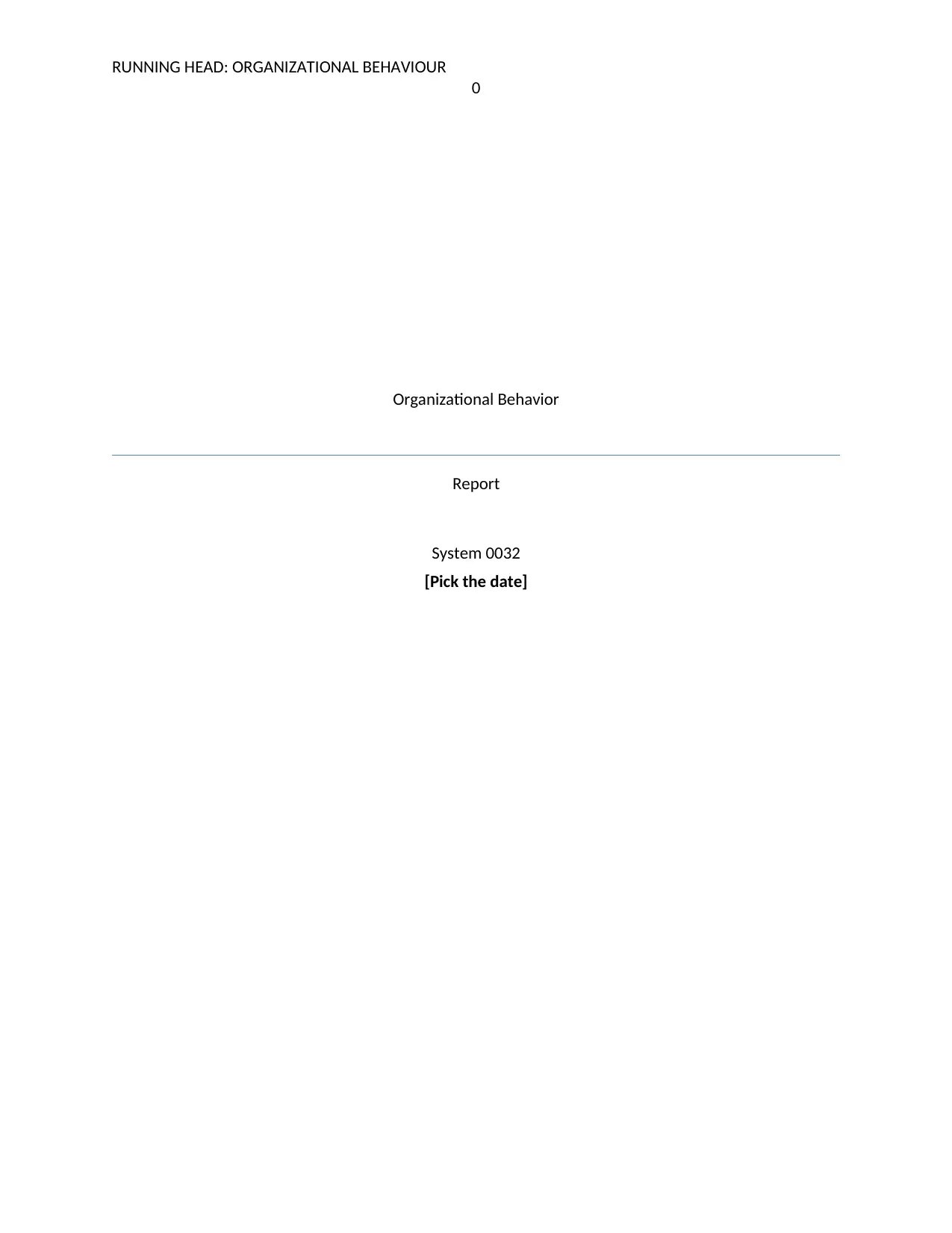
RUNNING HEAD: ORGANIZATIONAL BEHAVIOUR
0
Organizational Behavior
Report
System 0032
[Pick the date]
0
Organizational Behavior
Report
System 0032
[Pick the date]
Paraphrase This Document
Need a fresh take? Get an instant paraphrase of this document with our AI Paraphraser
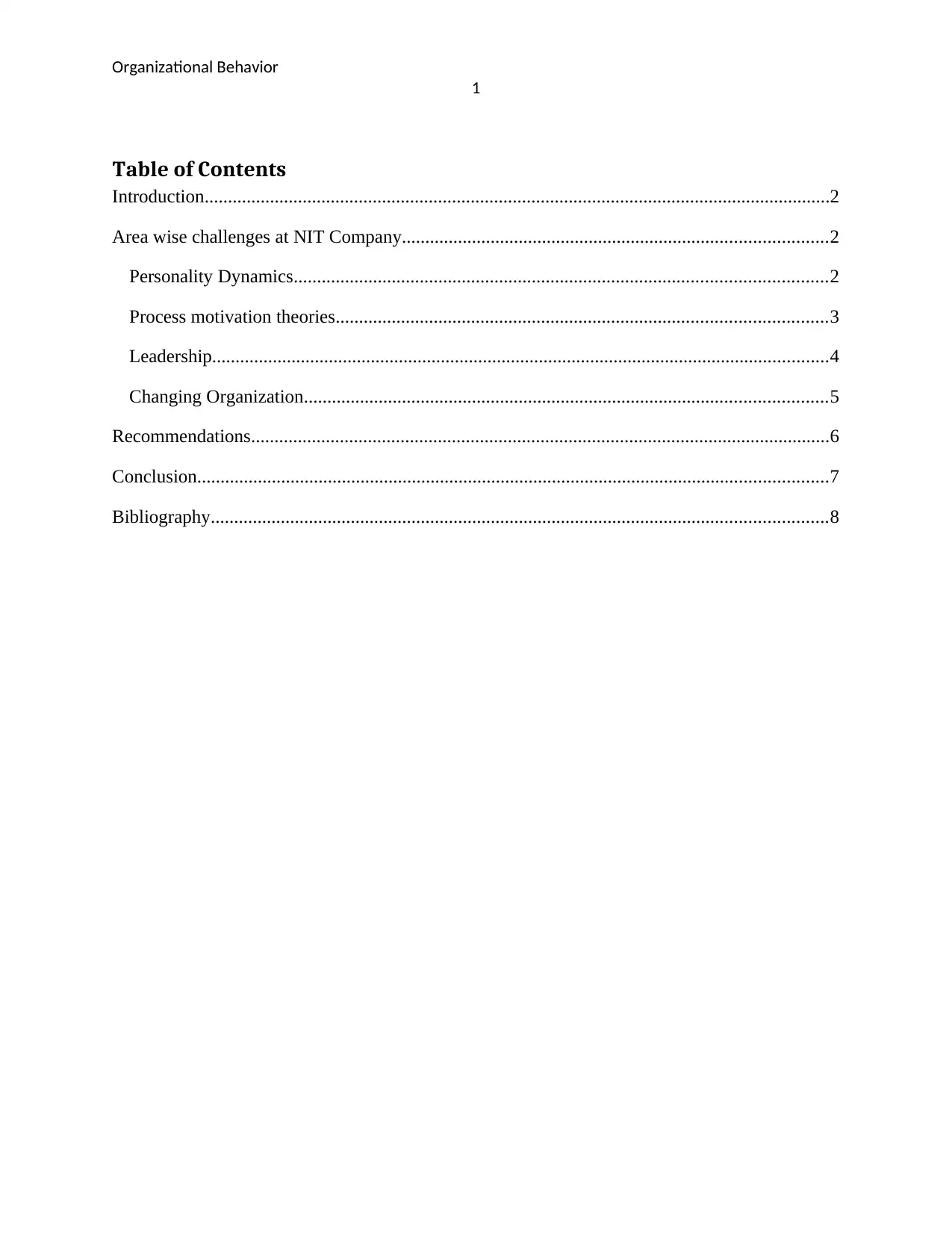
Organizational Behavior
1
Table of Contents
Introduction......................................................................................................................................2
Area wise challenges at NIT Company...........................................................................................2
Personality Dynamics..................................................................................................................2
Process motivation theories.........................................................................................................3
Leadership....................................................................................................................................4
Changing Organization................................................................................................................5
Recommendations............................................................................................................................6
Conclusion.......................................................................................................................................7
Bibliography....................................................................................................................................8
1
Table of Contents
Introduction......................................................................................................................................2
Area wise challenges at NIT Company...........................................................................................2
Personality Dynamics..................................................................................................................2
Process motivation theories.........................................................................................................3
Leadership....................................................................................................................................4
Changing Organization................................................................................................................5
Recommendations............................................................................................................................6
Conclusion.......................................................................................................................................7
Bibliography....................................................................................................................................8
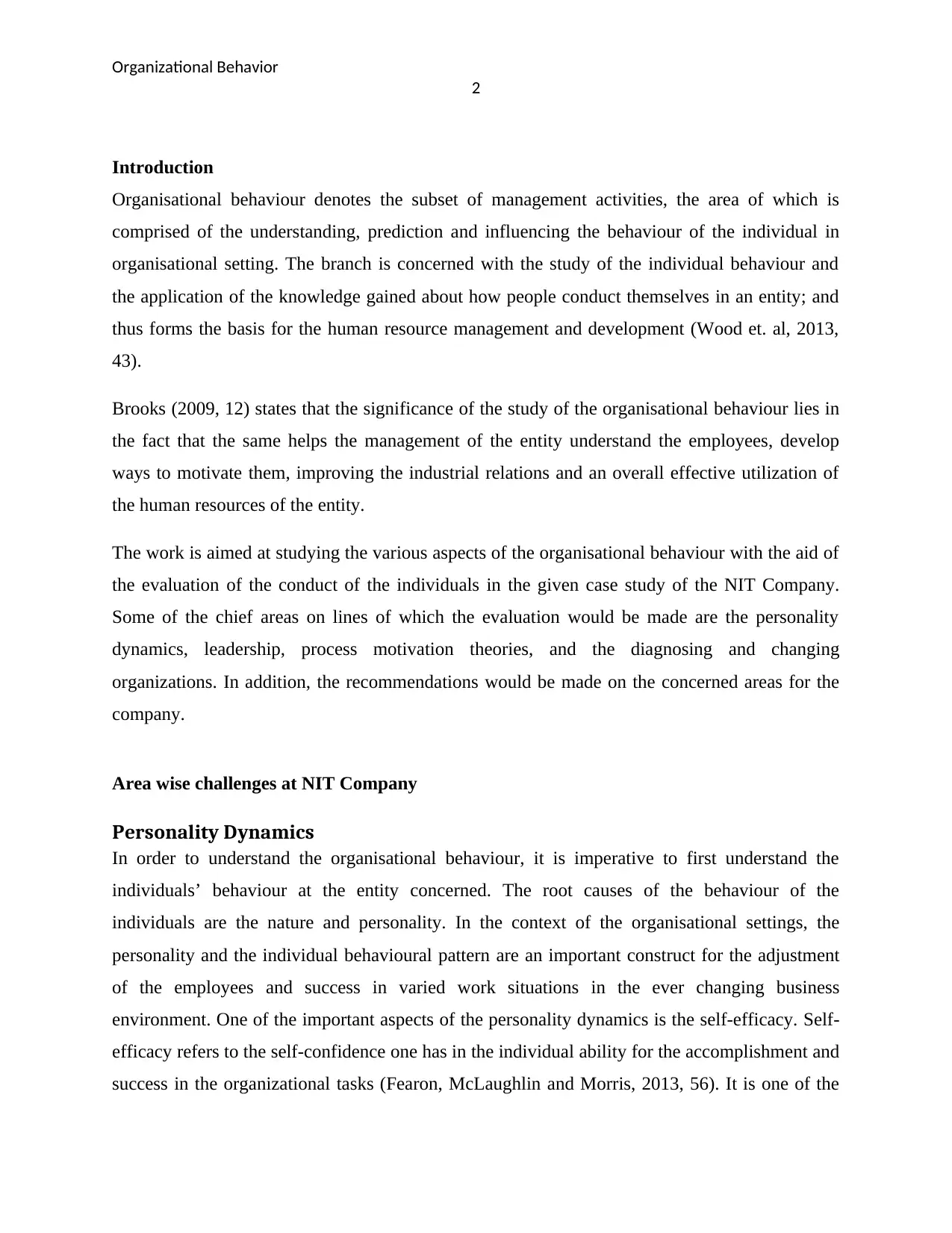
Organizational Behavior
2
Introduction
Organisational behaviour denotes the subset of management activities, the area of which is
comprised of the understanding, prediction and influencing the behaviour of the individual in
organisational setting. The branch is concerned with the study of the individual behaviour and
the application of the knowledge gained about how people conduct themselves in an entity; and
thus forms the basis for the human resource management and development (Wood et. al, 2013,
43).
Brooks (2009, 12) states that the significance of the study of the organisational behaviour lies in
the fact that the same helps the management of the entity understand the employees, develop
ways to motivate them, improving the industrial relations and an overall effective utilization of
the human resources of the entity.
The work is aimed at studying the various aspects of the organisational behaviour with the aid of
the evaluation of the conduct of the individuals in the given case study of the NIT Company.
Some of the chief areas on lines of which the evaluation would be made are the personality
dynamics, leadership, process motivation theories, and the diagnosing and changing
organizations. In addition, the recommendations would be made on the concerned areas for the
company.
Area wise challenges at NIT Company
Personality Dynamics
In order to understand the organisational behaviour, it is imperative to first understand the
individuals’ behaviour at the entity concerned. The root causes of the behaviour of the
individuals are the nature and personality. In the context of the organisational settings, the
personality and the individual behavioural pattern are an important construct for the adjustment
of the employees and success in varied work situations in the ever changing business
environment. One of the important aspects of the personality dynamics is the self-efficacy. Self-
efficacy refers to the self-confidence one has in the individual ability for the accomplishment and
success in the organizational tasks (Fearon, McLaughlin and Morris, 2013, 56). It is one of the
2
Introduction
Organisational behaviour denotes the subset of management activities, the area of which is
comprised of the understanding, prediction and influencing the behaviour of the individual in
organisational setting. The branch is concerned with the study of the individual behaviour and
the application of the knowledge gained about how people conduct themselves in an entity; and
thus forms the basis for the human resource management and development (Wood et. al, 2013,
43).
Brooks (2009, 12) states that the significance of the study of the organisational behaviour lies in
the fact that the same helps the management of the entity understand the employees, develop
ways to motivate them, improving the industrial relations and an overall effective utilization of
the human resources of the entity.
The work is aimed at studying the various aspects of the organisational behaviour with the aid of
the evaluation of the conduct of the individuals in the given case study of the NIT Company.
Some of the chief areas on lines of which the evaluation would be made are the personality
dynamics, leadership, process motivation theories, and the diagnosing and changing
organizations. In addition, the recommendations would be made on the concerned areas for the
company.
Area wise challenges at NIT Company
Personality Dynamics
In order to understand the organisational behaviour, it is imperative to first understand the
individuals’ behaviour at the entity concerned. The root causes of the behaviour of the
individuals are the nature and personality. In the context of the organisational settings, the
personality and the individual behavioural pattern are an important construct for the adjustment
of the employees and success in varied work situations in the ever changing business
environment. One of the important aspects of the personality dynamics is the self-efficacy. Self-
efficacy refers to the self-confidence one has in the individual ability for the accomplishment and
success in the organizational tasks (Fearon, McLaughlin and Morris, 2013, 56). It is one of the
⊘ This is a preview!⊘
Do you want full access?
Subscribe today to unlock all pages.

Trusted by 1+ million students worldwide
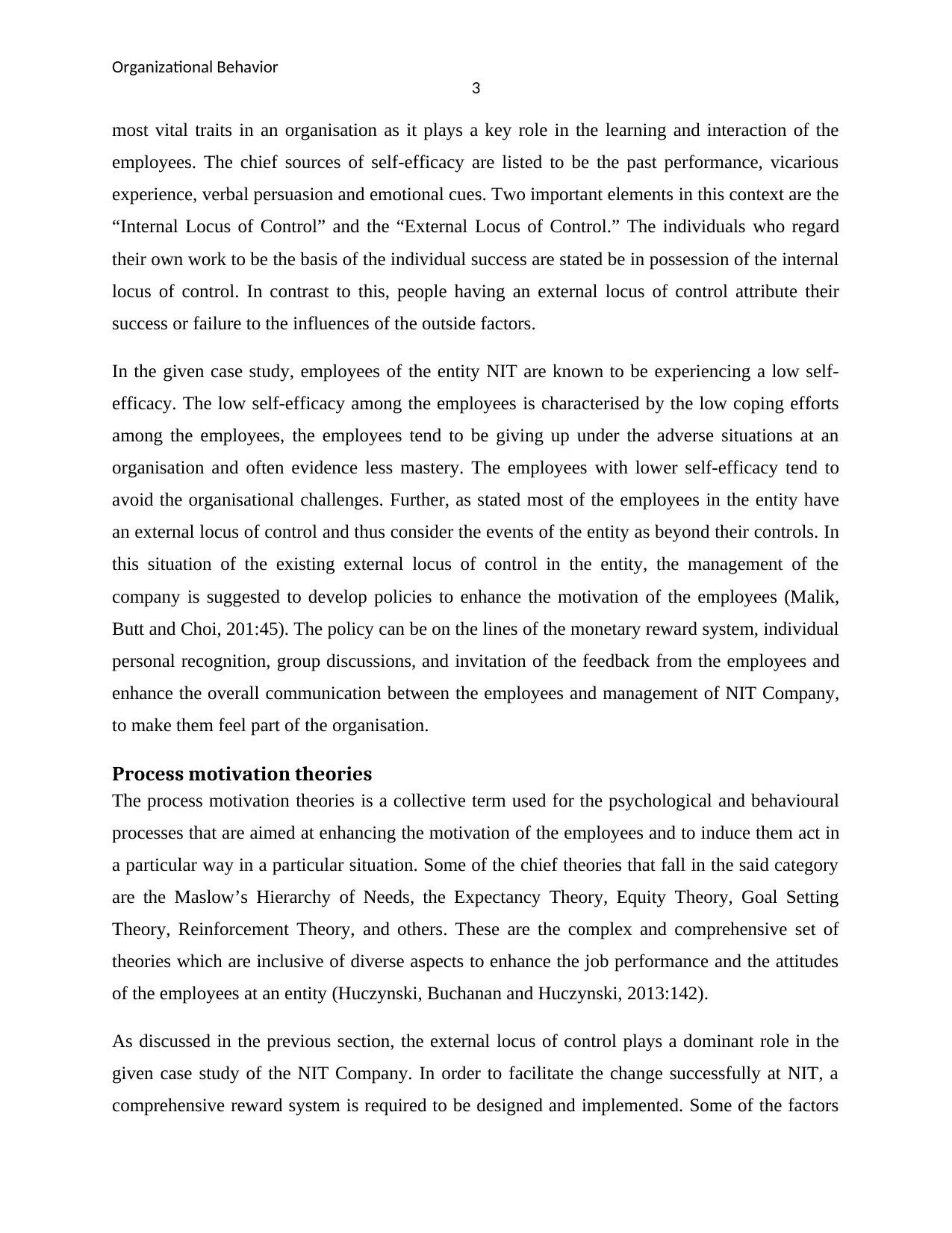
Organizational Behavior
3
most vital traits in an organisation as it plays a key role in the learning and interaction of the
employees. The chief sources of self-efficacy are listed to be the past performance, vicarious
experience, verbal persuasion and emotional cues. Two important elements in this context are the
“Internal Locus of Control” and the “External Locus of Control.” The individuals who regard
their own work to be the basis of the individual success are stated be in possession of the internal
locus of control. In contrast to this, people having an external locus of control attribute their
success or failure to the influences of the outside factors.
In the given case study, employees of the entity NIT are known to be experiencing a low self-
efficacy. The low self-efficacy among the employees is characterised by the low coping efforts
among the employees, the employees tend to be giving up under the adverse situations at an
organisation and often evidence less mastery. The employees with lower self-efficacy tend to
avoid the organisational challenges. Further, as stated most of the employees in the entity have
an external locus of control and thus consider the events of the entity as beyond their controls. In
this situation of the existing external locus of control in the entity, the management of the
company is suggested to develop policies to enhance the motivation of the employees (Malik,
Butt and Choi, 201:45). The policy can be on the lines of the monetary reward system, individual
personal recognition, group discussions, and invitation of the feedback from the employees and
enhance the overall communication between the employees and management of NIT Company,
to make them feel part of the organisation.
Process motivation theories
The process motivation theories is a collective term used for the psychological and behavioural
processes that are aimed at enhancing the motivation of the employees and to induce them act in
a particular way in a particular situation. Some of the chief theories that fall in the said category
are the Maslow’s Hierarchy of Needs, the Expectancy Theory, Equity Theory, Goal Setting
Theory, Reinforcement Theory, and others. These are the complex and comprehensive set of
theories which are inclusive of diverse aspects to enhance the job performance and the attitudes
of the employees at an entity (Huczynski, Buchanan and Huczynski, 2013:142).
As discussed in the previous section, the external locus of control plays a dominant role in the
given case study of the NIT Company. In order to facilitate the change successfully at NIT, a
comprehensive reward system is required to be designed and implemented. Some of the factors
3
most vital traits in an organisation as it plays a key role in the learning and interaction of the
employees. The chief sources of self-efficacy are listed to be the past performance, vicarious
experience, verbal persuasion and emotional cues. Two important elements in this context are the
“Internal Locus of Control” and the “External Locus of Control.” The individuals who regard
their own work to be the basis of the individual success are stated be in possession of the internal
locus of control. In contrast to this, people having an external locus of control attribute their
success or failure to the influences of the outside factors.
In the given case study, employees of the entity NIT are known to be experiencing a low self-
efficacy. The low self-efficacy among the employees is characterised by the low coping efforts
among the employees, the employees tend to be giving up under the adverse situations at an
organisation and often evidence less mastery. The employees with lower self-efficacy tend to
avoid the organisational challenges. Further, as stated most of the employees in the entity have
an external locus of control and thus consider the events of the entity as beyond their controls. In
this situation of the existing external locus of control in the entity, the management of the
company is suggested to develop policies to enhance the motivation of the employees (Malik,
Butt and Choi, 201:45). The policy can be on the lines of the monetary reward system, individual
personal recognition, group discussions, and invitation of the feedback from the employees and
enhance the overall communication between the employees and management of NIT Company,
to make them feel part of the organisation.
Process motivation theories
The process motivation theories is a collective term used for the psychological and behavioural
processes that are aimed at enhancing the motivation of the employees and to induce them act in
a particular way in a particular situation. Some of the chief theories that fall in the said category
are the Maslow’s Hierarchy of Needs, the Expectancy Theory, Equity Theory, Goal Setting
Theory, Reinforcement Theory, and others. These are the complex and comprehensive set of
theories which are inclusive of diverse aspects to enhance the job performance and the attitudes
of the employees at an entity (Huczynski, Buchanan and Huczynski, 2013:142).
As discussed in the previous section, the external locus of control plays a dominant role in the
given case study of the NIT Company. In order to facilitate the change successfully at NIT, a
comprehensive reward system is required to be designed and implemented. Some of the factors
Paraphrase This Document
Need a fresh take? Get an instant paraphrase of this document with our AI Paraphraser
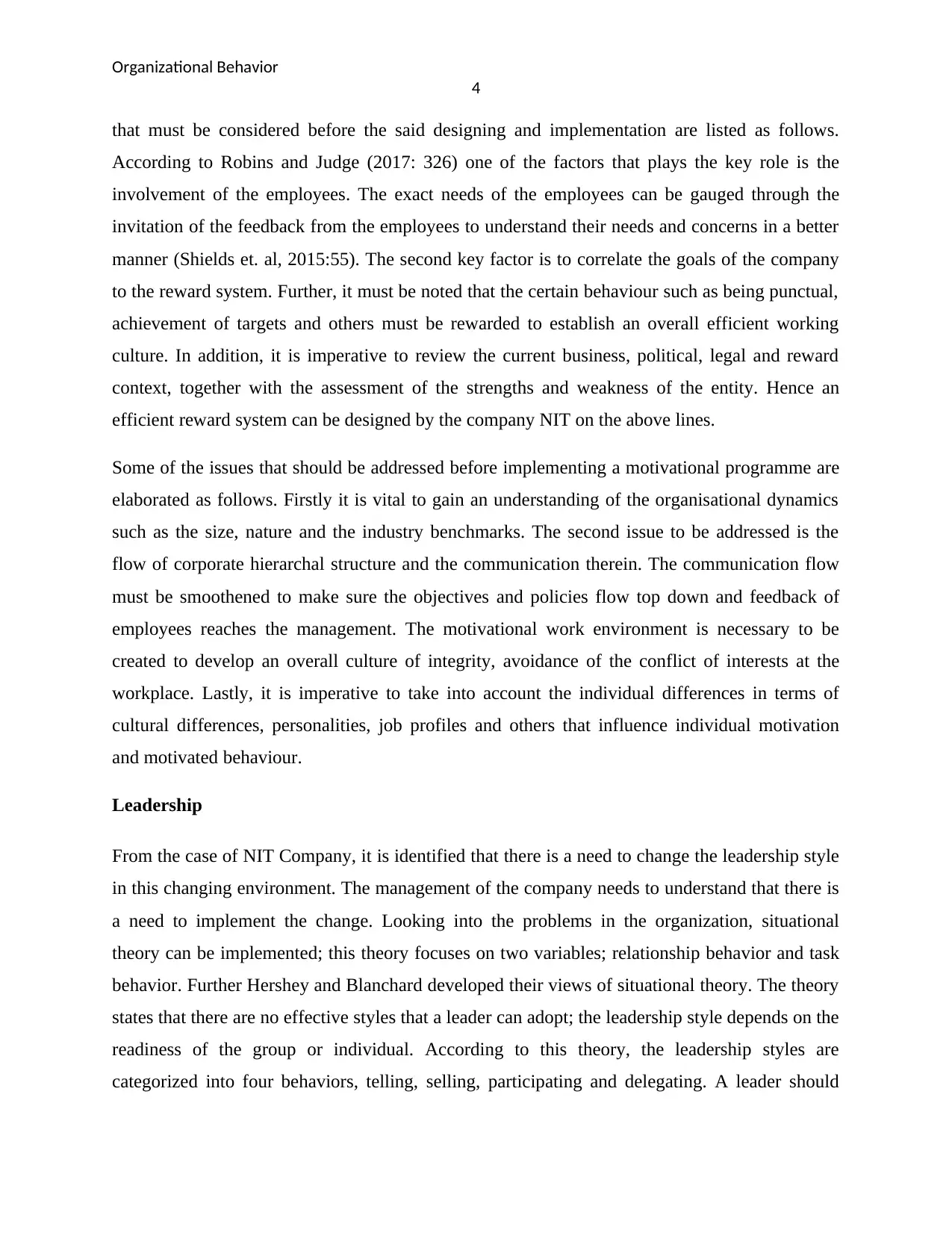
Organizational Behavior
4
that must be considered before the said designing and implementation are listed as follows.
According to Robins and Judge (2017: 326) one of the factors that plays the key role is the
involvement of the employees. The exact needs of the employees can be gauged through the
invitation of the feedback from the employees to understand their needs and concerns in a better
manner (Shields et. al, 2015:55). The second key factor is to correlate the goals of the company
to the reward system. Further, it must be noted that the certain behaviour such as being punctual,
achievement of targets and others must be rewarded to establish an overall efficient working
culture. In addition, it is imperative to review the current business, political, legal and reward
context, together with the assessment of the strengths and weakness of the entity. Hence an
efficient reward system can be designed by the company NIT on the above lines.
Some of the issues that should be addressed before implementing a motivational programme are
elaborated as follows. Firstly it is vital to gain an understanding of the organisational dynamics
such as the size, nature and the industry benchmarks. The second issue to be addressed is the
flow of corporate hierarchal structure and the communication therein. The communication flow
must be smoothened to make sure the objectives and policies flow top down and feedback of
employees reaches the management. The motivational work environment is necessary to be
created to develop an overall culture of integrity, avoidance of the conflict of interests at the
workplace. Lastly, it is imperative to take into account the individual differences in terms of
cultural differences, personalities, job profiles and others that influence individual motivation
and motivated behaviour.
Leadership
From the case of NIT Company, it is identified that there is a need to change the leadership style
in this changing environment. The management of the company needs to understand that there is
a need to implement the change. Looking into the problems in the organization, situational
theory can be implemented; this theory focuses on two variables; relationship behavior and task
behavior. Further Hershey and Blanchard developed their views of situational theory. The theory
states that there are no effective styles that a leader can adopt; the leadership style depends on the
readiness of the group or individual. According to this theory, the leadership styles are
categorized into four behaviors, telling, selling, participating and delegating. A leader should
4
that must be considered before the said designing and implementation are listed as follows.
According to Robins and Judge (2017: 326) one of the factors that plays the key role is the
involvement of the employees. The exact needs of the employees can be gauged through the
invitation of the feedback from the employees to understand their needs and concerns in a better
manner (Shields et. al, 2015:55). The second key factor is to correlate the goals of the company
to the reward system. Further, it must be noted that the certain behaviour such as being punctual,
achievement of targets and others must be rewarded to establish an overall efficient working
culture. In addition, it is imperative to review the current business, political, legal and reward
context, together with the assessment of the strengths and weakness of the entity. Hence an
efficient reward system can be designed by the company NIT on the above lines.
Some of the issues that should be addressed before implementing a motivational programme are
elaborated as follows. Firstly it is vital to gain an understanding of the organisational dynamics
such as the size, nature and the industry benchmarks. The second issue to be addressed is the
flow of corporate hierarchal structure and the communication therein. The communication flow
must be smoothened to make sure the objectives and policies flow top down and feedback of
employees reaches the management. The motivational work environment is necessary to be
created to develop an overall culture of integrity, avoidance of the conflict of interests at the
workplace. Lastly, it is imperative to take into account the individual differences in terms of
cultural differences, personalities, job profiles and others that influence individual motivation
and motivated behaviour.
Leadership
From the case of NIT Company, it is identified that there is a need to change the leadership style
in this changing environment. The management of the company needs to understand that there is
a need to implement the change. Looking into the problems in the organization, situational
theory can be implemented; this theory focuses on two variables; relationship behavior and task
behavior. Further Hershey and Blanchard developed their views of situational theory. The theory
states that there are no effective styles that a leader can adopt; the leadership style depends on the
readiness of the group or individual. According to this theory, the leadership styles are
categorized into four behaviors, telling, selling, participating and delegating. A leader should
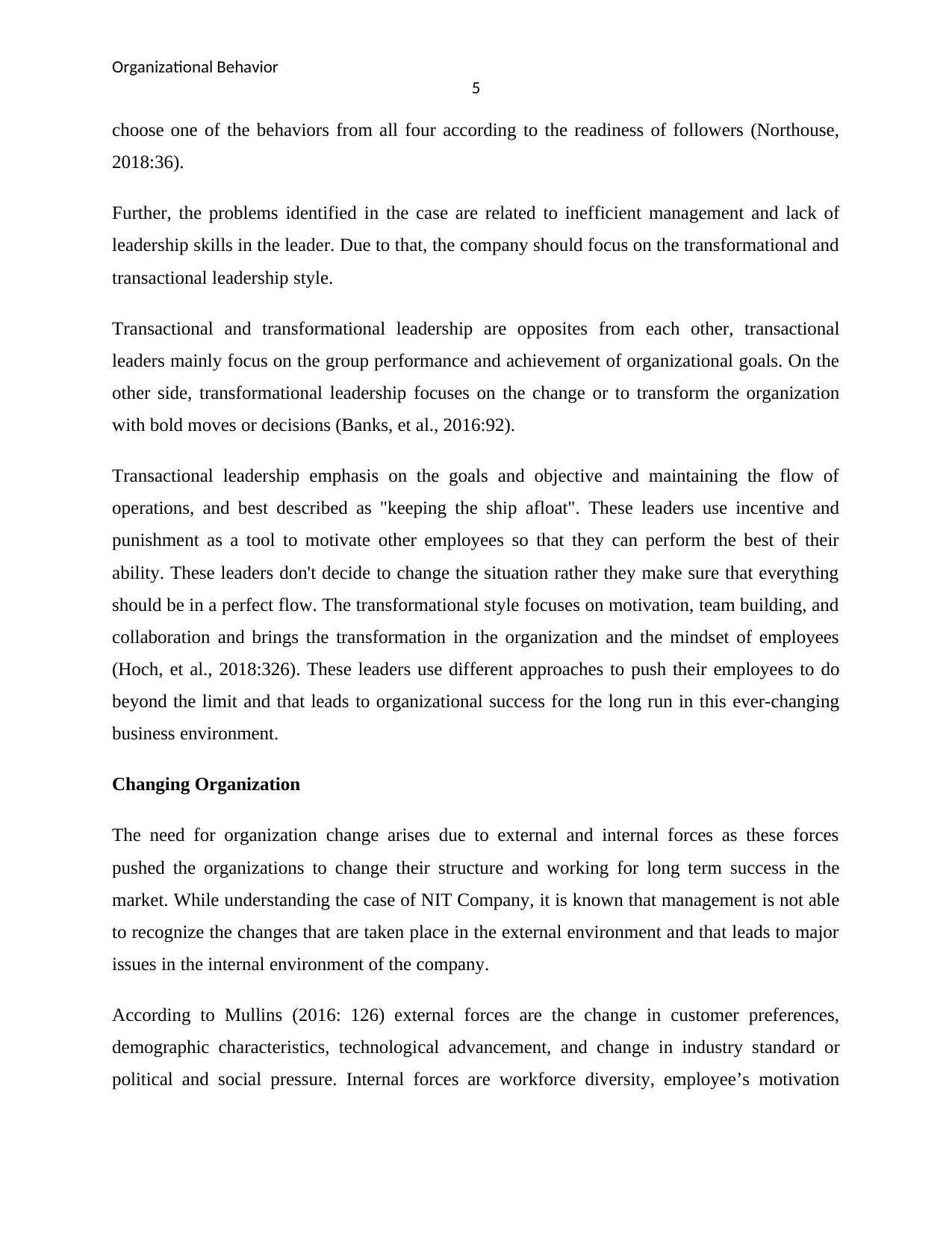
Organizational Behavior
5
choose one of the behaviors from all four according to the readiness of followers (Northouse,
2018:36).
Further, the problems identified in the case are related to inefficient management and lack of
leadership skills in the leader. Due to that, the company should focus on the transformational and
transactional leadership style.
Transactional and transformational leadership are opposites from each other, transactional
leaders mainly focus on the group performance and achievement of organizational goals. On the
other side, transformational leadership focuses on the change or to transform the organization
with bold moves or decisions (Banks, et al., 2016:92).
Transactional leadership emphasis on the goals and objective and maintaining the flow of
operations, and best described as "keeping the ship afloat". These leaders use incentive and
punishment as a tool to motivate other employees so that they can perform the best of their
ability. These leaders don't decide to change the situation rather they make sure that everything
should be in a perfect flow. The transformational style focuses on motivation, team building, and
collaboration and brings the transformation in the organization and the mindset of employees
(Hoch, et al., 2018:326). These leaders use different approaches to push their employees to do
beyond the limit and that leads to organizational success for the long run in this ever-changing
business environment.
Changing Organization
The need for organization change arises due to external and internal forces as these forces
pushed the organizations to change their structure and working for long term success in the
market. While understanding the case of NIT Company, it is known that management is not able
to recognize the changes that are taken place in the external environment and that leads to major
issues in the internal environment of the company.
According to Mullins (2016: 126) external forces are the change in customer preferences,
demographic characteristics, technological advancement, and change in industry standard or
political and social pressure. Internal forces are workforce diversity, employee’s motivation
5
choose one of the behaviors from all four according to the readiness of followers (Northouse,
2018:36).
Further, the problems identified in the case are related to inefficient management and lack of
leadership skills in the leader. Due to that, the company should focus on the transformational and
transactional leadership style.
Transactional and transformational leadership are opposites from each other, transactional
leaders mainly focus on the group performance and achievement of organizational goals. On the
other side, transformational leadership focuses on the change or to transform the organization
with bold moves or decisions (Banks, et al., 2016:92).
Transactional leadership emphasis on the goals and objective and maintaining the flow of
operations, and best described as "keeping the ship afloat". These leaders use incentive and
punishment as a tool to motivate other employees so that they can perform the best of their
ability. These leaders don't decide to change the situation rather they make sure that everything
should be in a perfect flow. The transformational style focuses on motivation, team building, and
collaboration and brings the transformation in the organization and the mindset of employees
(Hoch, et al., 2018:326). These leaders use different approaches to push their employees to do
beyond the limit and that leads to organizational success for the long run in this ever-changing
business environment.
Changing Organization
The need for organization change arises due to external and internal forces as these forces
pushed the organizations to change their structure and working for long term success in the
market. While understanding the case of NIT Company, it is known that management is not able
to recognize the changes that are taken place in the external environment and that leads to major
issues in the internal environment of the company.
According to Mullins (2016: 126) external forces are the change in customer preferences,
demographic characteristics, technological advancement, and change in industry standard or
political and social pressure. Internal forces are workforce diversity, employee’s motivation
⊘ This is a preview!⊘
Do you want full access?
Subscribe today to unlock all pages.

Trusted by 1+ million students worldwide
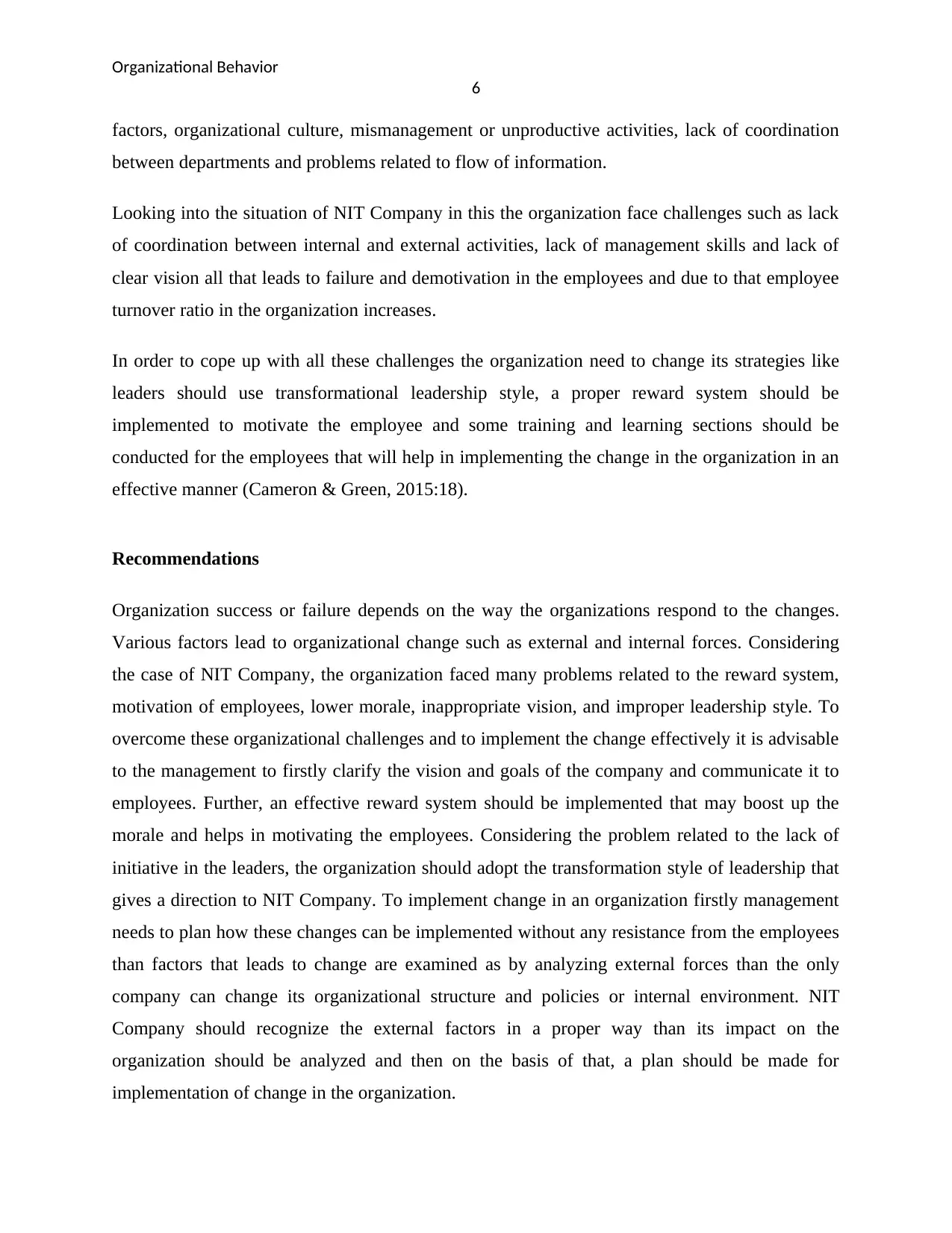
Organizational Behavior
6
factors, organizational culture, mismanagement or unproductive activities, lack of coordination
between departments and problems related to flow of information.
Looking into the situation of NIT Company in this the organization face challenges such as lack
of coordination between internal and external activities, lack of management skills and lack of
clear vision all that leads to failure and demotivation in the employees and due to that employee
turnover ratio in the organization increases.
In order to cope up with all these challenges the organization need to change its strategies like
leaders should use transformational leadership style, a proper reward system should be
implemented to motivate the employee and some training and learning sections should be
conducted for the employees that will help in implementing the change in the organization in an
effective manner (Cameron & Green, 2015:18).
Recommendations
Organization success or failure depends on the way the organizations respond to the changes.
Various factors lead to organizational change such as external and internal forces. Considering
the case of NIT Company, the organization faced many problems related to the reward system,
motivation of employees, lower morale, inappropriate vision, and improper leadership style. To
overcome these organizational challenges and to implement the change effectively it is advisable
to the management to firstly clarify the vision and goals of the company and communicate it to
employees. Further, an effective reward system should be implemented that may boost up the
morale and helps in motivating the employees. Considering the problem related to the lack of
initiative in the leaders, the organization should adopt the transformation style of leadership that
gives a direction to NIT Company. To implement change in an organization firstly management
needs to plan how these changes can be implemented without any resistance from the employees
than factors that leads to change are examined as by analyzing external forces than the only
company can change its organizational structure and policies or internal environment. NIT
Company should recognize the external factors in a proper way than its impact on the
organization should be analyzed and then on the basis of that, a plan should be made for
implementation of change in the organization.
6
factors, organizational culture, mismanagement or unproductive activities, lack of coordination
between departments and problems related to flow of information.
Looking into the situation of NIT Company in this the organization face challenges such as lack
of coordination between internal and external activities, lack of management skills and lack of
clear vision all that leads to failure and demotivation in the employees and due to that employee
turnover ratio in the organization increases.
In order to cope up with all these challenges the organization need to change its strategies like
leaders should use transformational leadership style, a proper reward system should be
implemented to motivate the employee and some training and learning sections should be
conducted for the employees that will help in implementing the change in the organization in an
effective manner (Cameron & Green, 2015:18).
Recommendations
Organization success or failure depends on the way the organizations respond to the changes.
Various factors lead to organizational change such as external and internal forces. Considering
the case of NIT Company, the organization faced many problems related to the reward system,
motivation of employees, lower morale, inappropriate vision, and improper leadership style. To
overcome these organizational challenges and to implement the change effectively it is advisable
to the management to firstly clarify the vision and goals of the company and communicate it to
employees. Further, an effective reward system should be implemented that may boost up the
morale and helps in motivating the employees. Considering the problem related to the lack of
initiative in the leaders, the organization should adopt the transformation style of leadership that
gives a direction to NIT Company. To implement change in an organization firstly management
needs to plan how these changes can be implemented without any resistance from the employees
than factors that leads to change are examined as by analyzing external forces than the only
company can change its organizational structure and policies or internal environment. NIT
Company should recognize the external factors in a proper way than its impact on the
organization should be analyzed and then on the basis of that, a plan should be made for
implementation of change in the organization.
Paraphrase This Document
Need a fresh take? Get an instant paraphrase of this document with our AI Paraphraser
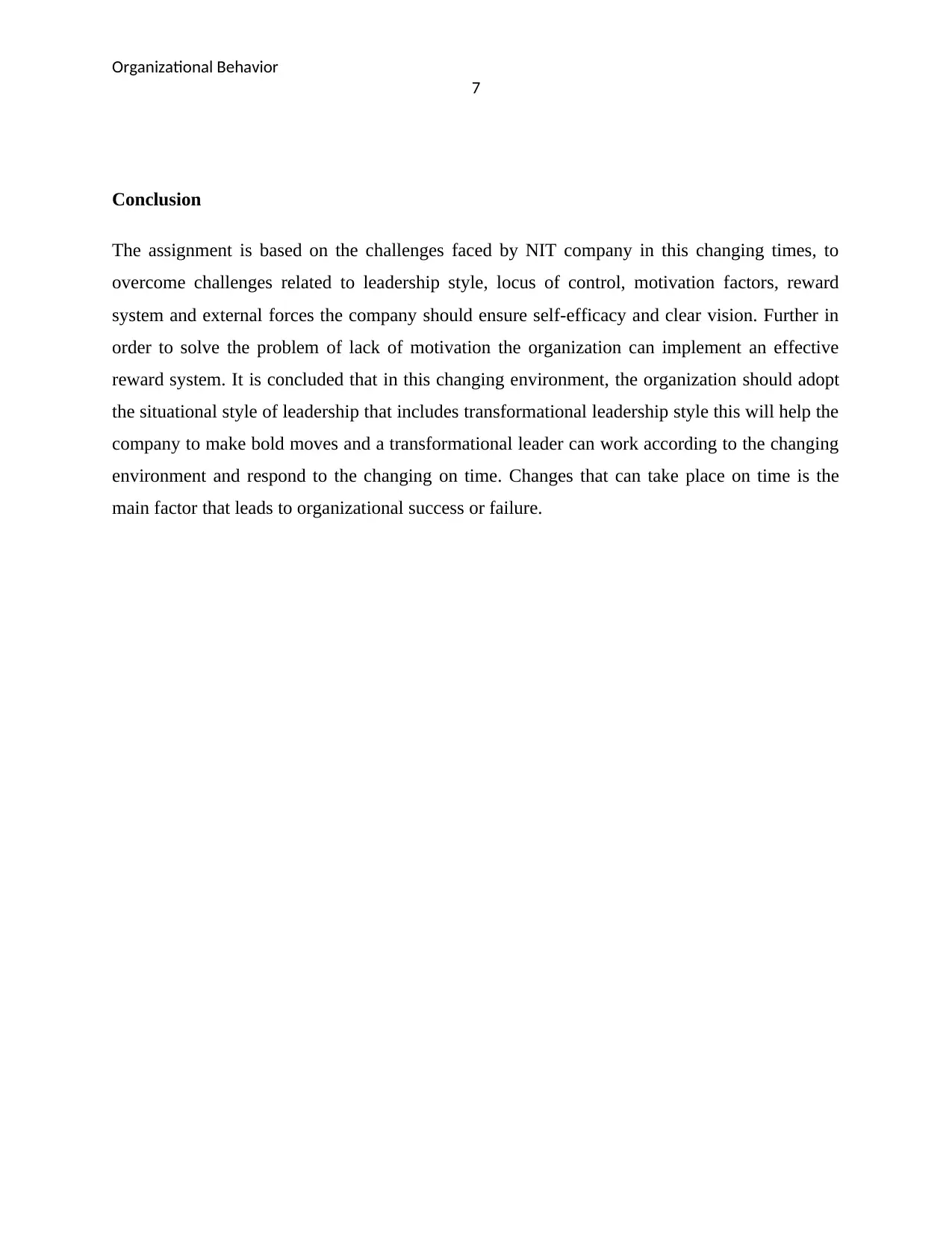
Organizational Behavior
7
Conclusion
The assignment is based on the challenges faced by NIT company in this changing times, to
overcome challenges related to leadership style, locus of control, motivation factors, reward
system and external forces the company should ensure self-efficacy and clear vision. Further in
order to solve the problem of lack of motivation the organization can implement an effective
reward system. It is concluded that in this changing environment, the organization should adopt
the situational style of leadership that includes transformational leadership style this will help the
company to make bold moves and a transformational leader can work according to the changing
environment and respond to the changing on time. Changes that can take place on time is the
main factor that leads to organizational success or failure.
7
Conclusion
The assignment is based on the challenges faced by NIT company in this changing times, to
overcome challenges related to leadership style, locus of control, motivation factors, reward
system and external forces the company should ensure self-efficacy and clear vision. Further in
order to solve the problem of lack of motivation the organization can implement an effective
reward system. It is concluded that in this changing environment, the organization should adopt
the situational style of leadership that includes transformational leadership style this will help the
company to make bold moves and a transformational leader can work according to the changing
environment and respond to the changing on time. Changes that can take place on time is the
main factor that leads to organizational success or failure.
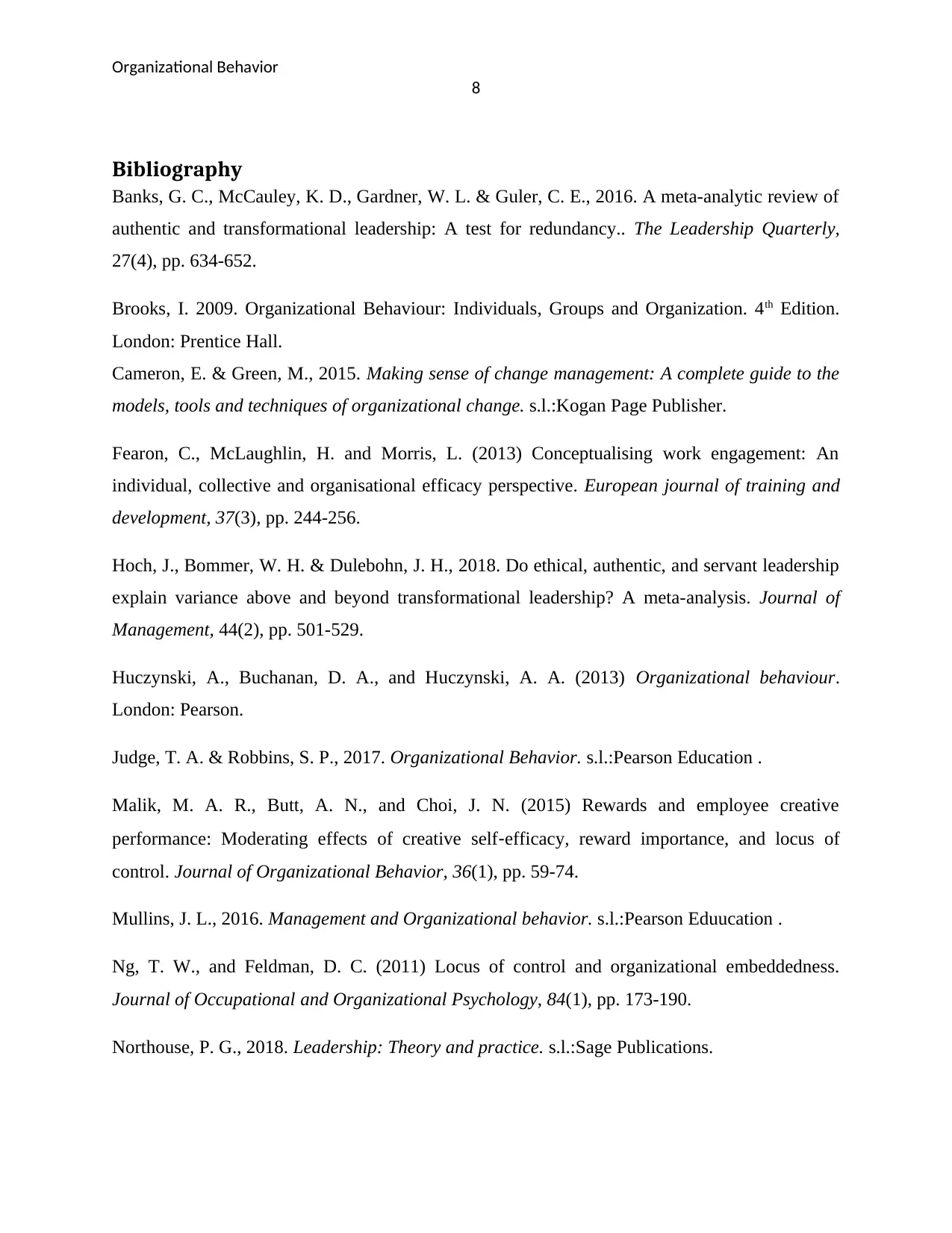
Organizational Behavior
8
Bibliography
Banks, G. C., McCauley, K. D., Gardner, W. L. & Guler, C. E., 2016. A meta-analytic review of
authentic and transformational leadership: A test for redundancy.. The Leadership Quarterly,
27(4), pp. 634-652.
Brooks, I. 2009. Organizational Behaviour: Individuals, Groups and Organization. 4th Edition.
London: Prentice Hall.
Cameron, E. & Green, M., 2015. Making sense of change management: A complete guide to the
models, tools and techniques of organizational change. s.l.:Kogan Page Publisher.
Fearon, C., McLaughlin, H. and Morris, L. (2013) Conceptualising work engagement: An
individual, collective and organisational efficacy perspective. European journal of training and
development, 37(3), pp. 244-256.
Hoch, J., Bommer, W. H. & Dulebohn, J. H., 2018. Do ethical, authentic, and servant leadership
explain variance above and beyond transformational leadership? A meta-analysis. Journal of
Management, 44(2), pp. 501-529.
Huczynski, A., Buchanan, D. A., and Huczynski, A. A. (2013) Organizational behaviour.
London: Pearson.
Judge, T. A. & Robbins, S. P., 2017. Organizational Behavior. s.l.:Pearson Education .
Malik, M. A. R., Butt, A. N., and Choi, J. N. (2015) Rewards and employee creative
performance: Moderating effects of creative self‐efficacy, reward importance, and locus of
control. Journal of Organizational Behavior, 36(1), pp. 59-74.
Mullins, J. L., 2016. Management and Organizational behavior. s.l.:Pearson Eduucation .
Ng, T. W., and Feldman, D. C. (2011) Locus of control and organizational embeddedness.
Journal of Occupational and Organizational Psychology, 84(1), pp. 173-190.
Northouse, P. G., 2018. Leadership: Theory and practice. s.l.:Sage Publications.
8
Bibliography
Banks, G. C., McCauley, K. D., Gardner, W. L. & Guler, C. E., 2016. A meta-analytic review of
authentic and transformational leadership: A test for redundancy.. The Leadership Quarterly,
27(4), pp. 634-652.
Brooks, I. 2009. Organizational Behaviour: Individuals, Groups and Organization. 4th Edition.
London: Prentice Hall.
Cameron, E. & Green, M., 2015. Making sense of change management: A complete guide to the
models, tools and techniques of organizational change. s.l.:Kogan Page Publisher.
Fearon, C., McLaughlin, H. and Morris, L. (2013) Conceptualising work engagement: An
individual, collective and organisational efficacy perspective. European journal of training and
development, 37(3), pp. 244-256.
Hoch, J., Bommer, W. H. & Dulebohn, J. H., 2018. Do ethical, authentic, and servant leadership
explain variance above and beyond transformational leadership? A meta-analysis. Journal of
Management, 44(2), pp. 501-529.
Huczynski, A., Buchanan, D. A., and Huczynski, A. A. (2013) Organizational behaviour.
London: Pearson.
Judge, T. A. & Robbins, S. P., 2017. Organizational Behavior. s.l.:Pearson Education .
Malik, M. A. R., Butt, A. N., and Choi, J. N. (2015) Rewards and employee creative
performance: Moderating effects of creative self‐efficacy, reward importance, and locus of
control. Journal of Organizational Behavior, 36(1), pp. 59-74.
Mullins, J. L., 2016. Management and Organizational behavior. s.l.:Pearson Eduucation .
Ng, T. W., and Feldman, D. C. (2011) Locus of control and organizational embeddedness.
Journal of Occupational and Organizational Psychology, 84(1), pp. 173-190.
Northouse, P. G., 2018. Leadership: Theory and practice. s.l.:Sage Publications.
⊘ This is a preview!⊘
Do you want full access?
Subscribe today to unlock all pages.

Trusted by 1+ million students worldwide
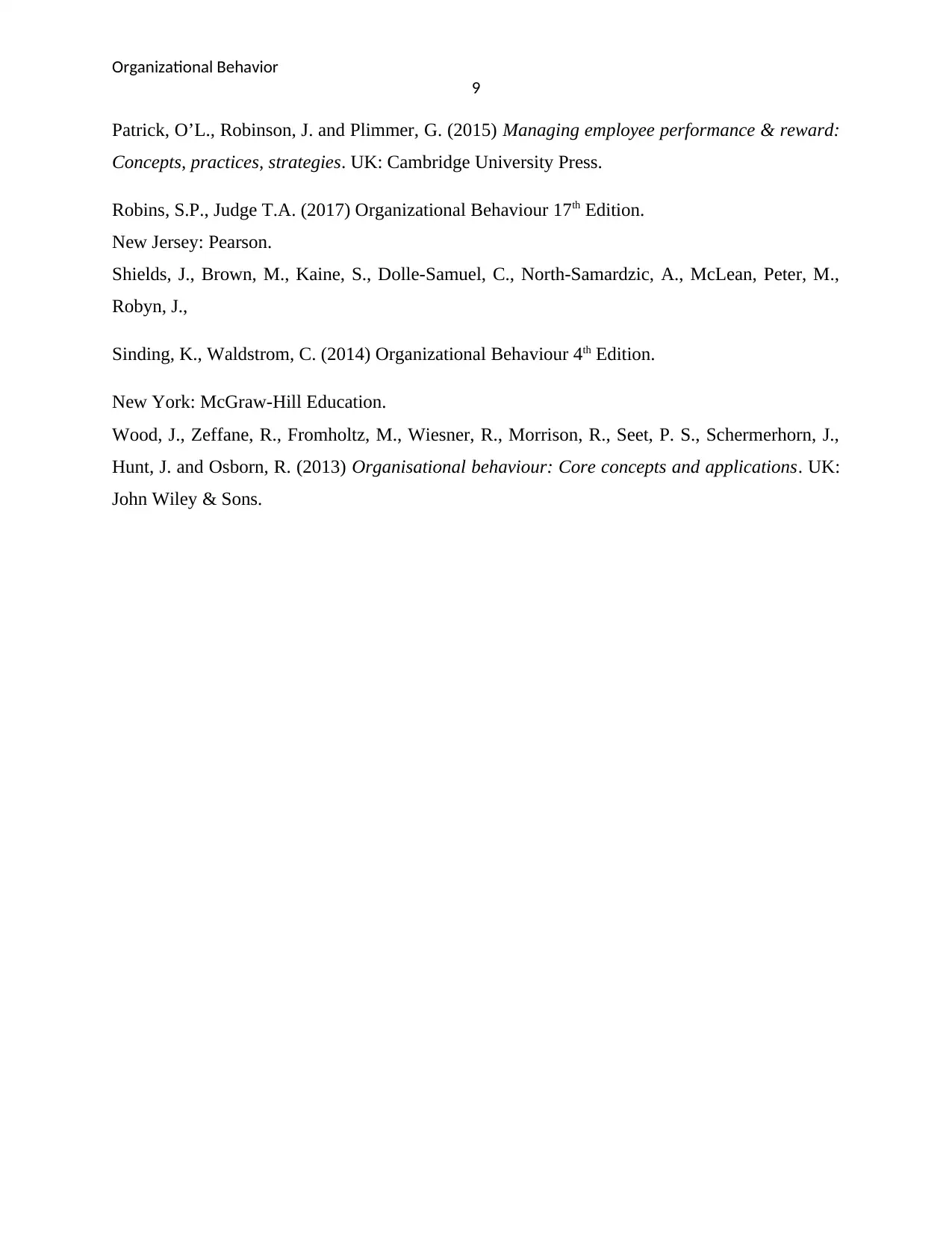
Organizational Behavior
9
Patrick, O’L., Robinson, J. and Plimmer, G. (2015) Managing employee performance & reward:
Concepts, practices, strategies. UK: Cambridge University Press.
Robins, S.P., Judge T.A. (2017) Organizational Behaviour 17th Edition.
New Jersey: Pearson.
Shields, J., Brown, M., Kaine, S., Dolle-Samuel, C., North-Samardzic, A., McLean, Peter, M.,
Robyn, J.,
Sinding, K., Waldstrom, C. (2014) Organizational Behaviour 4th Edition.
New York: McGraw-Hill Education.
Wood, J., Zeffane, R., Fromholtz, M., Wiesner, R., Morrison, R., Seet, P. S., Schermerhorn, J.,
Hunt, J. and Osborn, R. (2013) Organisational behaviour: Core concepts and applications. UK:
John Wiley & Sons.
9
Patrick, O’L., Robinson, J. and Plimmer, G. (2015) Managing employee performance & reward:
Concepts, practices, strategies. UK: Cambridge University Press.
Robins, S.P., Judge T.A. (2017) Organizational Behaviour 17th Edition.
New Jersey: Pearson.
Shields, J., Brown, M., Kaine, S., Dolle-Samuel, C., North-Samardzic, A., McLean, Peter, M.,
Robyn, J.,
Sinding, K., Waldstrom, C. (2014) Organizational Behaviour 4th Edition.
New York: McGraw-Hill Education.
Wood, J., Zeffane, R., Fromholtz, M., Wiesner, R., Morrison, R., Seet, P. S., Schermerhorn, J.,
Hunt, J. and Osborn, R. (2013) Organisational behaviour: Core concepts and applications. UK:
John Wiley & Sons.
1 out of 10
Related Documents
Your All-in-One AI-Powered Toolkit for Academic Success.
+13062052269
info@desklib.com
Available 24*7 on WhatsApp / Email
![[object Object]](/_next/static/media/star-bottom.7253800d.svg)
Unlock your academic potential
Copyright © 2020–2025 A2Z Services. All Rights Reserved. Developed and managed by ZUCOL.





